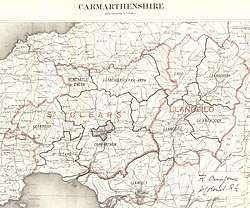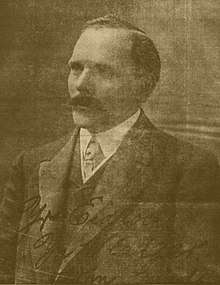West Carmarthenshire (UK Parliament constituency)
West Carmarthenshire was a parliamentary constituency in Wales which returned one Member of Parliament to the House of Commons of the Parliament of the United Kingdom.
| West Carmarthenshire | |
|---|---|
| Former County constituency for the House of Commons | |
 Carmathenshire boundaries | |
| 1885–1918 | |
| Number of members | one |
| Replaced by | Carmarthen |
| Created from | Carmarthenshire |
It was created for the 1885 general election, when the old two-member Carmarthenshire constituency was divided into two new single-member seats: East Carmarthenshire and West Carmarthenshire, both of which were in turn abolished for the 1918 general election.
Boundaries
The constituency included the Sessional Divisions of Carmarthen, Llanboidy, Llanfihangel-ar-Arth, Newcastle Emlyn, and St Clears, and parts of the Sessional Divisions of Llandilo and Llandovery. It was an almost exclusively rural and agricultural constituency, with the only significant industry being the tinplate works at Kidwelly in the extreme south of the constituency and the woollen mills around Newcastle Emlyn.[1]
Members of Parliament
| Election | Member | Party | |
|---|---|---|---|
| 1885 | W. R. H. Powell | Liberal | |
| 1889 | John Lloyd Morgan | Liberal | |
| 1910, December | John Hinds | Liberal | |
| 1918 | constituency abolished | ||
History
1885-88
At the first election in 1885, the two sitting members for the former constituency of Carmarthenshire faced each other. The Conservative candidate, Viscount Emlyn, although most of his family property lay in the eastern part of the county, calculated that his chances there would be negligible given the growing industrial population which had been a key factor in the triumph of the Liberal candidate, Edward Sartoris at the 1868 general election. He was opposed by the Liberal W.R.H. Powell, himself a former Conservative supporter who had first declared his support for the Liberals at the 1874 election. Powell now proclaimed that he had a duty to the Liberal cause to oppose Emlyn.[2]
It was reported that the Conservatives were confident of their chances in the new West Carmarthenshire constituency, on the grounds that it was largely an agricultural division. However, the electorate had more than doubled in the county, and the 1885 electorate in the Western Division alone exceeded that of the combined county seat in 1880.[1] However, the overwhelmingly nonconformist character of the constituency was regarded as a distinct advantage to the Liberal candidate, and the influence of the chapels predicted to be decisive in view of their direct influence over rural agricultural communities.[1]
After a vigorous contest, Powell won a decisive victory.[3]
By the next election the following year, Emlyn had retired from the fray, and Powell increased his majority significantly.[4]

| Party | Candidate | Votes | % | ± | |
|---|---|---|---|---|---|
| Liberal | W. R. H. Powell | 4,568 | 60.8 | N/A | |
| Conservative | Frederick Campbell | 2,942 | 39.2 | N/A | |
| Majority | 1,626 | 21.6 | N/A | ||
| Turnout | 7,510 | 75.3 | N/A | ||
| Registered electors | 9,969 | ||||
| Liberal win (new seat) | |||||
| Party | Candidate | Votes | % | ± | |
|---|---|---|---|---|---|
| Liberal | W. R. H. Powell | 4,181 | 68.6 | +7.8 | |
| Liberal Unionist | James Lawrence | 1,916 | 31.4 | -7.8 | |
| Majority | 2,265 | 37.2 | +15.6 | ||
| Turnout | 6,097 | 61.2 | -14.1 | ||
| Registered electors | 9,969 | ||||
| Liberal hold | Swing | +7.8 | |||
1889 by-election
Powell died in 1889. After a short campaign he was succeeded by John Lloyd Morgan who comfortably won the by-election.[6]

| Party | Candidate | Votes | % | ± | |
|---|---|---|---|---|---|
| Liberal | John Lloyd Morgan | 4,252 | 62.7 | -5.9 | |
| Conservative | Hugh Williams-Drummond | 2,533 | 37.3 | +5.9 | |
| Majority | 1,719 | 25.4 | -11.8 | ||
| Turnout | 6,785 | 72.3 | +11.1 | ||
| Registered electors | 9,379 | ||||
| Liberal hold | Swing | -5.9 | |||
1890-1910
Morgan was returned unopposed in 1890. In 1895, however, the Conservatives had their best result in the history the constituency, and their candidate, W.J. Buckley of Llanelli, fought a vigorous campaign supported by local landowners.[7] He was still, however, some distance short of victory.
Lloyd Morgan was opposed for the first time for fifteen years at the first General Election of 1910. His opponent, a Welsh-speaking barrister from Manchester, fought a vigorous campaign but made little impression. Later that year it was announced that Morgan was being made a judge and would not contest the second General Election.[8]
| Party | Candidate | Votes | % | ± | |
|---|---|---|---|---|---|
| Liberal | John Lloyd Morgan | Unopposed | |||
| Liberal hold | |||||
| Party | Candidate | Votes | % | ± | |
|---|---|---|---|---|---|
| Liberal | John Lloyd Morgan | 4,143 | 57.2 | N/A | |
| Liberal Unionist | William Joseph Buckley | 3,103 | 42.8 | N/A | |
| Majority | 1,040 | 14.4 | N/A | ||
| Turnout | 7,246 | 79.7 | N/A | ||
| Registered electors | 9,097 | ||||
| Liberal hold | Swing | N/A | |||
| Party | Candidate | Votes | % | ± | |
|---|---|---|---|---|---|
| Liberal | John Lloyd Morgan | Unopposed | |||
| Liberal hold | |||||
| Party | Candidate | Votes | % | ± | |
|---|---|---|---|---|---|
| Liberal | John Lloyd Morgan | Unopposed | |||
| Liberal hold | |||||
| Party | Candidate | Votes | % | ± | |
|---|---|---|---|---|---|
| Liberal | John Lloyd Morgan | Unopposed | |||
| Liberal hold | |||||
| Party | Candidate | Votes | % | ± | |
|---|---|---|---|---|---|
| Liberal | John Lloyd Morgan | 5,684 | 73.4 | N/A | |
| Conservative | John William Jones Cremlin | 2,059 | 26.6 | N/A | |
| Majority | 3,625 | 46.8 | N/A | ||
| Turnout | 7,743 | 82.1 | N/A | ||
| Liberal hold | Swing | N/A | |||
The second 1910 general election
Six candidates contested the nomination, including Sir Owen Philipps, who had latterly stood down as member for Pembroke Boroughs, and Courtenay Mansel. The final choice was between John Hinds, a native of Carmarthen who was now a successful businessman in London and Henry Jones-Davies, who was both a prominent member of Carmarthenshire County Council and brother-in-law of the late Liberal politician, Tom Ellis. Jones-Davies had led throughout the Hinds won the final ballot by 188 votes against 186.[11]
At the election that followed, Hinds was opposed by Jones Cremlyn, who was once again the Conservative candidate. It was suggested at one stage that the Rev Arthur Fuller Mills of Carmarthen, chairman of Carmarthenshire County Council, would contest the seat as an independent but the rumour proved unfounded.[12] Jones Cremlyn fought vigorous campaign, which was enthusiastically supported by the Carmarthen Journal and addressed meetings throughout the constituency, travelling from village to village by motor car.[13]
Following the election, a Carmarthen Journal editorial complained about the dominance of the Liberals in the constituency and the means by which nonconformist ministers sustained them.[14]

| Party | Candidate | Votes | % | ± | |
|---|---|---|---|---|---|
| Liberal | John Hinds | 5,076 | 71.4 | -2.0 | |
| Conservative | John William Jones Cremlin | 2,036 | 28.6 | +2.0 | |
| Majority | 3,040 | 42.8 | -4.0 | ||
| Turnout | 7,112 | 75.4 | -6.7 | ||
| Liberal hold | Swing | -2.0 | |||
Another General Election was required to take place before the end of 1915. The political parties had been making preparations for an election to take place and by the July 1914, Alfred Stephens of Kidwelly had been chosen to oppose John Hinds.[15]
References
- "Election Prospects in South Wales. Carmarthenshire,". South Wales Daily News. 2 November 1885. p. 3. Retrieved 11 November 2015.
- "Liberal Meeting at Newcastle Emlyn". South Wales Daily News. 24 October 1885. p. 3. Retrieved 14 September 2015.
- "West Carmarthen, Return of Mr Powell". South Wales Daily News. 4 December 1885. p. 3. Retrieved 14 September 2015.
- "West Carmarthen, Triumphant Return of the Ministerial Candidate". South Wales Daily News. 17 July 1886. p. 3. Retrieved 14 September 2015.
- British Parliamentary Election Results 1885-1918, FWS Craig
- "West Carmarthenshire Election". Carmarthen Journal. 19 July 1889. Retrieved 6 December 2014.
- "West Carmarthenshire". Welshman. 19 July 1895. p. 3. Retrieved 6 June 2016.
- "Editorial". Carmarthen Journal. 18 November 1910. Retrieved 13 December 2014.
- Debrett's House of Commons & Judicial Bench, 1901
- Debrett's House of Commons & Judicial Bench, 1916
- "The Fight for West Wales". Carmarthen Journal. 25 November 1910. Retrieved 12 December 2014.
- "Notes of the Week". Carmarthen Journal. 18 November 1910. Retrieved 13 December 2014.
- "West Carmarthenshire. Enthusiastic Receptions for the Unionist Candidate". Carmarthen Journal. 9 December 1910. Retrieved 18 December 2014.
- "Why and Wherefore (editorial)". Carmarthen Journal. 16 December 1910. Retrieved 23 December 2014.
- Western Mail 24 Jul 1914